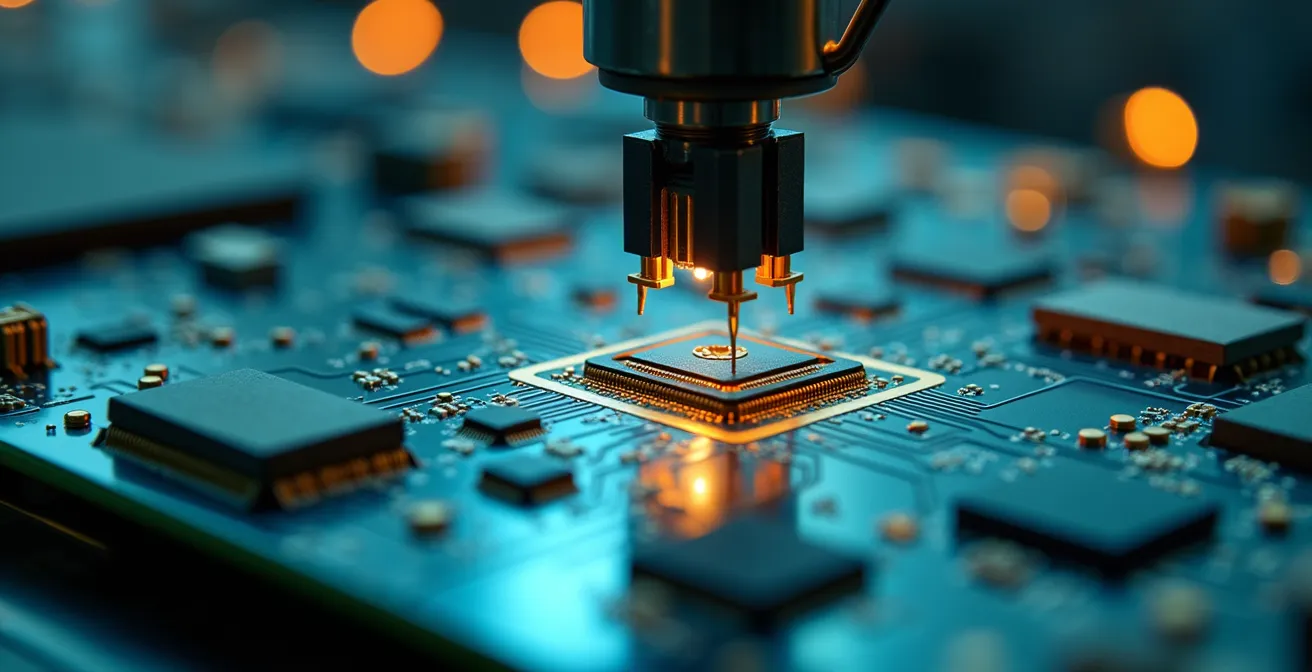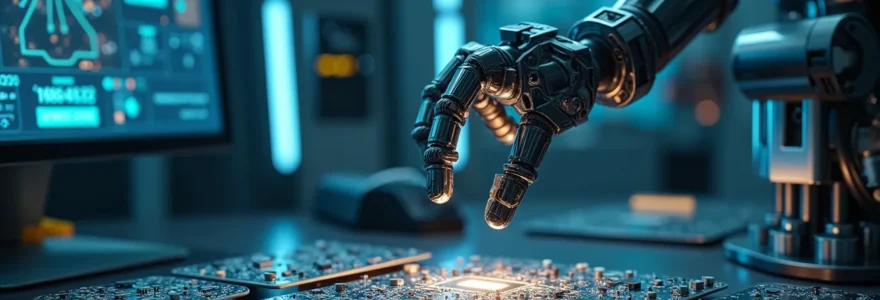In the world of robotics and automation, progress is measured in milliseconds, micrometers, and lines of code. Yet, the true engine of innovation often lies hidden within the electronic nervous system of every machine: the Printed Circuit Board (PCB). The conversation around PCBs has long been dominated by speed and cost, but this view is becoming outdated. The real story is that rapid prototyping has evolved from a simple accelerator into a strategic enabler, fundamentally shaping a robot’s intelligence, resilience, and capabilities. It’s the critical process that transforms theoretical designs into functional, robust systems capable of tackling complex, real-world challenges. For any team serious about leading the next wave of automation, partnering with a specialized PCB prototype & fabrication manufacturer is no longer optional; it’s the cornerstone of success.
Your robotics prototyping blueprint
- Understand why robotics demands specialized PCBs for functions like sensor fusion and AI processing.
- Learn the key criteria for selecting a manufacturing partner beyond just speed and price.
- Discover how agile prototyping drives breakthrough innovation and maximizes return on investment.
- Explore the role of PCB development in integrating future-critical concepts like cybersecurity and HRI.
Bridging robotics’ unique demands: How rapid PCB prototyping fuels innovation
Robotics presents a unique set of challenges that push standard electronic design to its limits. Modern robots are not simple machines; they are complex systems that must perform real-time sensor fusion, execute intricate motor controls, and often run sophisticated AI algorithms directly on board. These demands necessitate highly specialized PCBs that traditional, slower prototyping methods struggle to accommodate effectively. The ability to quickly iterate on designs is paramount for progress.
What makes robotics PCBs so different?
Robotics PCBs must manage complex tasks like real-time data from multiple sensors, precise motor control, and onboard AI processing. They also require exceptional durability to withstand constant motion, vibration, and harsh operating environments, demanding specialized materials and design validation.
For instance, the development of autonomous vehicles relies on the ability to rapidly test and refine PCBs that handle immense data loads from LiDAR, cameras, and radar. Similarly, the agile navigation of drones requires compact, lightweight, and power-efficient boards that can only be perfected through iterative design. Rapid prototyping provides the agility needed to explore advanced technologies like high-frequency circuits for seamless communication or complex multi-layer boards that integrate entire systems onto a single, compact platform. This iterative process allows for an up to 70% reduction in prototyping time enabling faster project completion, which is a critical competitive advantage.
Rapid custom PCB prototyping minimizes wasted time, allowing roboticists to meet tight deadlines and stay ahead of the competition.
– Capel PCB Manufacturing, Rapid Custom PCB Prototyping for Robotic Applications
This introductory visual captures the essence of modern robotics electronics. The intricate pathways and components are not just circuits; they are the neural pathways that enable a robot’s perception, decision-making, and physical action. Prototyping allows these complex designs to be tested and validated quickly.

Beyond functionality, durability is non-negotiable. Robotics PCBs are subject to constant motion, vibration, and often extreme temperatures. Rapid prototyping enables engineers to conduct early-stage testing on various materials and structural designs, ensuring the final product is robust enough to perform reliably throughout its operational lifespan. This early validation prevents costly failures and redesigns down the line.
Advanced PCB prototyping accelerates UAV and autonomous vehicle development
The use of rapid iteration on PCBs in autonomous vehicles addresses environmental sensing complexity, while drone navigation benefits from compact, power-efficient board designs enabling innovative functionality testing.
The strategic imperative: Selecting a specialized PCB partner for robotics
Choosing a PCB manufacturer for a robotics project involves looking far beyond simple metrics like speed and cost. The right partner acts as a strategic collaborator who understands the unique demands of the field. Critical criteria include a deep expertise in robotics-specific components, such as microcontrollers with integrated motor drivers and advanced sensor interfaces, which are fundamental for mechatronic systems. This specialized knowledge is crucial for successful rapid PCB prototyping for innovation.
A manufacturer’s experience with relevant certifications is also paramount. For high-reliability applications common in industrial or medical robotics, compliance with standards like IPC Class 3 is essential. As an industry expert report for 2025 notes, selecting a PCB manufacturer with expertise in robotics-specific components and compliance standards is critical for ensuring performance and reliability. A specialized partner can also help mitigate supply chain vulnerabilities. Their established relationships with suppliers of unique robotic components and their knowledge of suitable materials for demanding applications can prevent significant delays and ensure project continuity. This is a key way to streamline manufacturing supply chain operations.
To aid in this crucial decision, here is a comparison of some leading manufacturers who specialize in the robotics sector, each offering a distinct set of capabilities.
| Manufacturer | Location | Specialization | Notable Features |
|---|---|---|---|
| South-Electronic | China | Multilayer, Flexible PCBs for Robotics | PCB assembly, High-frequency PCBs, Strict quality control |
| Advanced Circuits | USA | Quick-turn Prototyping, High-volume | Multi-layer PCBs, Rigid-flex, Fast delivery |
| Eurocircuits | Netherlands | Rapid prototyping, multilayer PCBs | Automated manufacturing, Sustainability focus |
| TTM Technologies | USA | High-frequency and complex PCBs | Advanced packaging, High-precision manufacturing |
Furthermore, advanced assembly capabilities, such as Surface Mount Technology (SMT) for fine-pitch components, Ball Grid Array (BGA) placement, and rigid-flex assembly, are vital for the compact and complex designs typical of modern robots. As one robotics manufacturer’s experience highlighted, their engineering team saw a 30% reduction in iteration time due to their partner’s free DFM analysis and quick turnaround, which greatly accelerated product launches. This underscores the value of collaborative support.
Checklist for choosing your robotics PCB partner
- Expertise in robotics-grade PCB materials and designs
- Ability to handle complex multilayer and rigid-flex boards
- Experience with IPC Class 3 compliance and certifications
- Advanced assembly capabilities including SMT, BGA, rigid-flex
- Supply chain reliability and component availability
- Strong design for manufacturability (DFM) support and collaboration
Beyond speed: Prototyping as a catalyst for robotic system evolution
While accelerated timelines are a clear benefit, the true power of rapid prototyping lies in its ability to transform the entire innovation process. It fosters a culture of radical design exploration, empowering engineers to test unconventional ideas and pursue breakthrough functionalities rather than settling for safe, incremental improvements. This agile approach is where true competitive advantages are born.
The financial impact is significant. By de-risking designs at an early stage, companies can achieve an up to 40% reduction in development costs with accelerated time-to-market. This reduction in Total Cost of Ownership (TCO) is not just about saving money on materials; it’s about avoiding costly redesigns, minimizing project delays, and capturing market share faster in the highly competitive automation landscape.
Rapid prototyping fosters radical design exploration, enabling breakthrough innovations rather than just incremental improvements.
– Capel Manufacturing Experts, Rapid Custom PCB Prototyping for Robotic Applications
This connection is particularly evident in the development of sophisticated AI and machine learning capabilities. Rapid PCB iteration allows for the creation of custom hardware tailored for edge computing or specialized processing units, enabling robots to make intelligent decisions locally without relying on the cloud. This is a critical step towards creating truly autonomous systems.
Using rapid PCB iteration to integrate AI/ML edge computing in robotics
Rapid prototyping allows development of sophisticated AI/ML robotic systems with custom hardware tailored for edge computing, enabling breakthroughs beyond incremental improvements.
Finally, agile prototyping allows robotics companies to be more responsive to market shifts and evolving customer demands. In a fast-paced sector, the ability to quickly adapt a design or integrate a new feature can be the difference between leading the market and falling behind. This requires a set of agile practices that keep the hardware development cycle as dynamic as the software one.
Key Agile Prototyping Practices
- Incorporate iterative feedback loops with customers
- Deploy small-batch prototypes for fast validation
- Leverage modular designs for rapid feature integration
- Maintain close collaboration between hardware and software teams
Key Takeaways
- Rapid PCB prototyping is a strategic enabler for complex features like AI, not just a time-saver.
- Selecting a partner requires evaluating robotics-specific expertise, compliance experience, and advanced assembly capabilities.
- Agile iteration reduces long-term costs and TCO by de-risking designs early in the development cycle.
- Prototyping is essential for integrating next-generation concepts like cybersecurity and advanced Human-Robot Interaction.
Engineering the future: Integrating advanced concepts via rapid PCB development
Looking ahead, rapid PCB development is the gateway to integrating the next generation of robotics concepts. One of the most critical areas is cybersecurity. As connected robots become more prevalent, their vulnerability to cyber threats grows. A recent report highlights that nearly 2 million industrial robots worldwide face growing cybersecurity risks in 2025. Prototyping allows for the early integration and testing of cybersecurity-hardened PCBs, enabling the detection and mitigation of vulnerabilities before a robot is deployed. According to a TÜV Rheinland Report, industrial robots require a thorough cybersecurity risk review and the implementation of proportionate controls to ensure safe and secure operation.
The visual below conceptualizes this integration, where digital shields and encrypted pathways are built directly into the robot’s hardware foundation. This “security by design” approach, facilitated by prototyping, is far more effective than software patches applied as an afterthought.

This hardware-centric security model is already being put into practice. By embedding security features directly onto the PCB, engineers can create a robust defense against attacks that target a robot’s core control systems, ensuring both operational integrity and physical safety.
Robust cybersecurity implementation in robot joint controllers
Integration of dedicated security ICs in robot joints ensures secure boot and encrypted communication without impacting real-time control, exemplifying distributed security architecture.
Beyond security, rapid prototyping is crucial for exploring novel human-robot interaction (HRI) features, advanced safety mechanisms, and next-generation power solutions. Prototyping energy-efficient architectures is essential for extending the battery life and operational endurance of autonomous mobile robots. It also facilitates the integration of cutting-edge sensor technologies and more powerful edge computing capabilities, paving the way for robots that are more intelligent, adaptive, and seamlessly integrated into our world.
Frequently asked questions on PCB prototyping
What is the main difference between standard and robotics PCB prototyping?
The main difference lies in the complexity and durability requirements. Robotics PCBs must handle real-time data from multiple sensors, control motors with high precision, and withstand constant vibration and mechanical stress. Prototyping for robotics therefore focuses heavily on testing specialized components, material resilience, and complex, multi-layer designs under operational conditions.
Why is IPC Class 3 compliance important for robotics?
IPC Class 3 is the strictest standard for high-reliability electronics. It is important for robotics used in critical applications like medical surgery, industrial automation, or aerospace because it ensures the highest level of manufacturing quality and rigor, minimizing the risk of board failure that could have serious consequences.
How does rapid prototyping reduce the total cost of ownership (TCO) for a robotics project?
Rapid prototyping reduces TCO by identifying and resolving design flaws early in the development cycle, which is far less expensive than fixing them after production has started. It prevents costly re-tooling, reduces wasted materials, accelerates time-to-market, and results in a more reliable final product with lower long-term maintenance and failure costs.
Can rapid prototyping help with the cybersecurity of a robot?
Yes, absolutely. Rapid prototyping allows engineers to test and integrate hardware-based security features directly onto the PCB, such as secure microcontrollers and encryption chips. This “security by design” approach creates a much more robust defense against cyber threats than relying solely on software patches after the fact.
